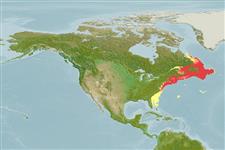Common names from other countries
Environment: milieu / climate zone / depth range / distribution range
экология
морской донно-пелагический; немигрирующий; пределы глубины 16 - 1000 m (Ref. 1371), usually 90 - 700 m (Ref. 1371). Subtropical; 59°N - 24°N, 81°W - 42°W (Ref. 1371)
Northwest Atlantic: Newfoundland, Canada to the northern end of the Straits of Florida, USA. A species reported from the northeastern Atlantic (Ref. 6321) should be reexamined. Report of specimen from the Azores and records from the Gulf of Mexico and West Indies (Ref. 6322) probably refer to other species.
Size / Вес / Возраст
Maturity: Lm ? range ? - ? cm
Max length : 40.0 cm TL самец/пол неопределен; (Ref. 1371); наибольший возраст (опубликованны данные): 11 годы (Ref. 40732)
колючие лучи спинного плавника (общее число) : 2; колючие лучи анального плавника: 0. Snout pointed; naked area on snout confined to median-ventral strip, otherwise head surfaces completely scaled. Spinules on scales slender, conical to lanceolate, arranged in convergent rows. Color when fresh gray with violet hue on trunk and lower jaw; silvery reflections on gill cover, parts of the suborbital, and trunk and tail below the lateral line; pelvic fins and membrane between spinous dorsal ray and first segmented ray black; pectoral and median fins otherwise dusky; oral and branchial cavities mostly black.
Benthic, reported as deep as 2295m (Ref. 58426). Taken much shallower in areas with cold surface waters. Feeds primarily on euphausiids, amphipods, and polychaetes, although a 200 mm individual had many copepods in its stomach (Ref. 1371).
Life cycle and mating behavior
Maturities | размножение | Spawnings | Egg(s) | Fecundities | личинки
Cohen, D.M., T. Inada, T. Iwamoto and N. Scialabba, 1990. FAO species catalogue. Vol. 10. Gadiform fishes of the world (Order Gadiformes). An annotated and illustrated catalogue of cods, hakes, grenadiers and other gadiform fishes known to date. FAO Fish. Synop. 125(10). Rome: FAO. 442 p. (Ref. 1371)
Статус Красного Списка МСОП (Ref. 130435)
CITES (Ref. 128078)
Not Evaluated
Угроза для людей
Harmless
Использование человеком
рыболовство: не имеет хозяйственного значения
дополнительная информация
инструменты
Специальные отчеты
Скачать в формате XML
ресурсы в Интернет
Estimates based on models
Preferred temperature (Ref.
115969): 0.6 - 7.8, mean 3.7 (based on 335 cells).
Phylogenetic diversity index (Ref.
82804): PD
50 = 0.5000 [Uniqueness, from 0.5 = low to 2.0 = high].
Bayesian length-weight: a=0.00219 (0.00111 - 0.00431), b=3.20 (3.03 - 3.37), in cm Total Length, based on LWR estimates for this (Sub)family-body shape (Ref.
93245).
Trophic level (Ref.
69278): 3.3 ±0.1 se; based on diet studies.
устойчивость к внешним воздействиям (Ref.
120179): средний (среднего размера), минимальное время удвоения популяции 1.4-4.4 года (K=0.28).
Fishing Vulnerability (Ref.
59153): Low to moderate vulnerability (30 of 100).
